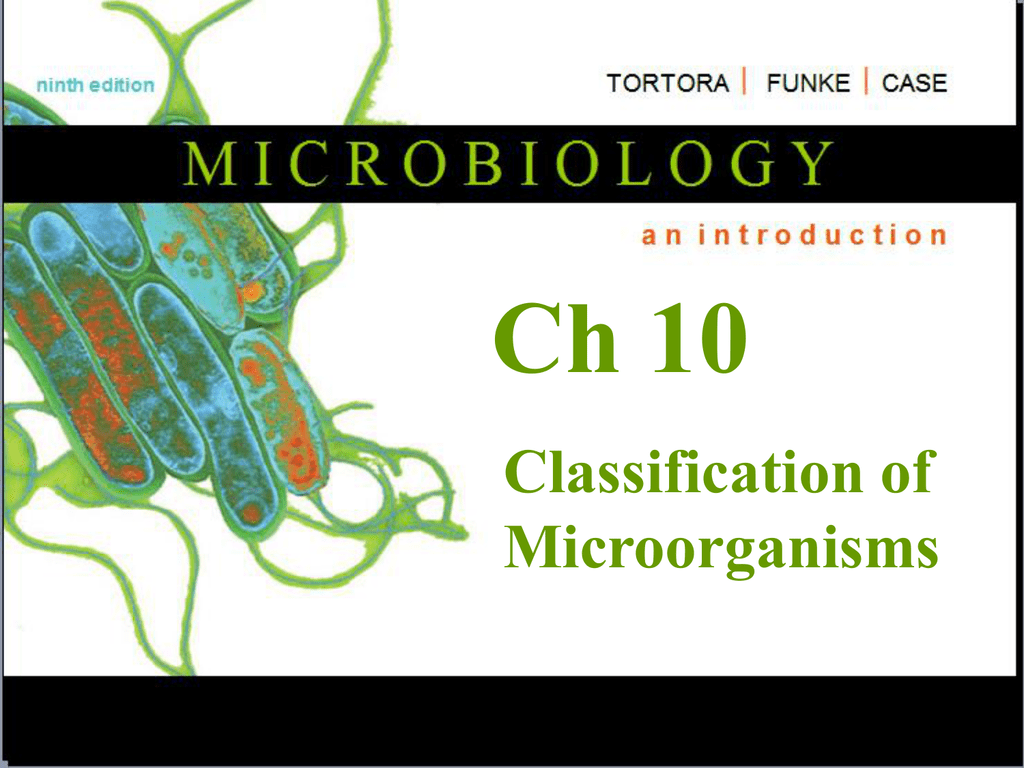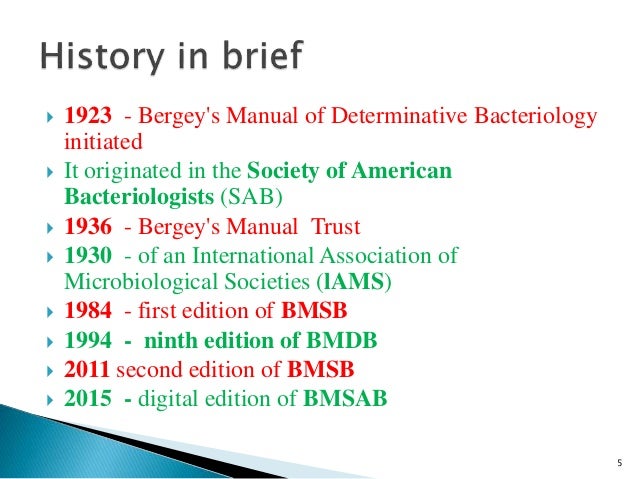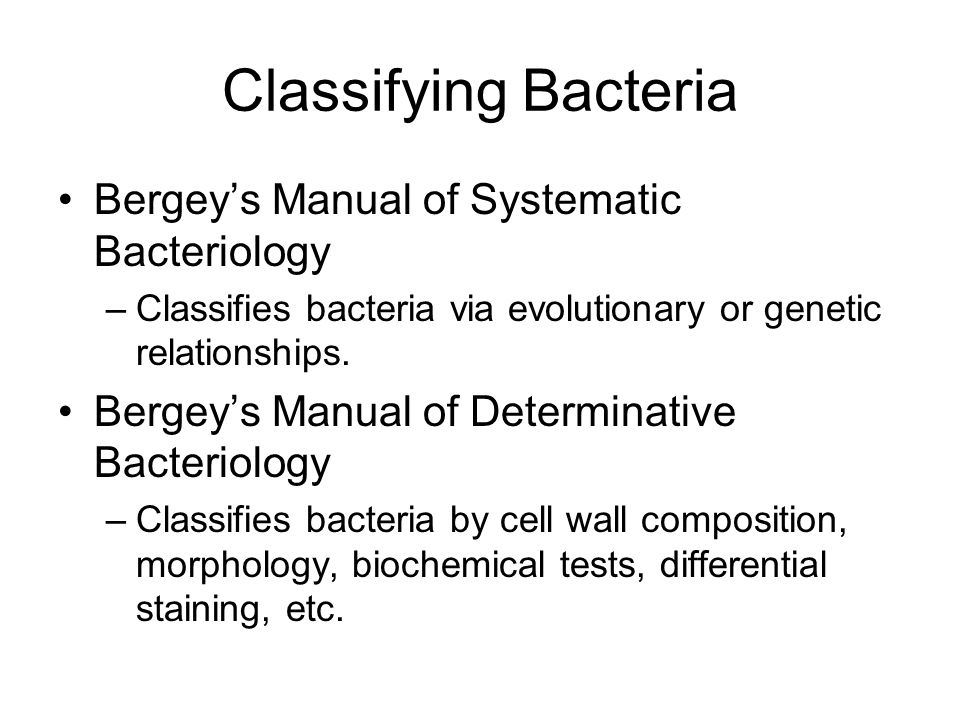
The first thing you'll need to do is determine your unknown's group number. To do that, you will need to consult Bergey's Manual of Determinative Bacteriology (9th edition). To find your group number, look through the table of contents of the manual, and use the table that starts on page 17. Most unknowns will be in one of these groups:
ISBN: 032: OCLC Number: 855674952: Notes: Includes index. Description: 1 online resource (xviii, 787 pages): illustrations: Other Titles. Bergey's Manual of Determinative Bacteriology / Edition 9 by John G. Sneath (Editor), Noel R. I need this book for my researches and it will be very interesting for. Summary Systematic information will continue to be found in Bergey's Manual Of Systematic Bacteriology, with the Determinative manual serving as a reference to aid in the identification of unknown bacteria. This edition is intended solely for the identification of those bacteria that have been described and cultured.
- Gram-Negative, Aerobic/Microaerophilic Rods and Cocci --Group 4
- Facultatively Anaerobic Gram-Negative Rods --Group 5
- Gram-Positive Cocci --Group 17
- Endospore-Forming Gram-Positive Rods and Cocci --Group 18
- Regular, Nonsporing Gram-Positive Rods --Group 19
- Irregular, Nonsporing Gram-Positive Rods --Group 20
- Aerobic, Nonmotile, Nonsporing, Acid-fast, Weakly Gram-Positive Rods --Group 21
Once you think you know your group number (or you have a few possibilities) go to the pages for your group within the manual. From there, you should find more information to help you make a final determination that you have the right group. You might also consult the information below to help you find the best tables to make a final determination about your unknown's group number:


Table 4.1, pp. 103-116
pigments/fluorescent, motility, growth requirements, denitrification, morphology, oxidase
5
Table 5.1, pg. 202
growth factors, morphology, gram reaction, oxidase
17
Aerobic genera: Table 17.1, pg 534
Facultatively anaerobic genera: Table 17.2, pg. 535-536
Strictly anaerobic genera: Table 17.3, pg. 537
oxygen requirements, morphology, growth requirements (45°C and supplements)
18
Table 18.1, pg. 562
oxygen requirements, motility, morphology, catalase
19
Table 19.1, pg. 568
morphology, oxygen requirements, catalase
20
Aerobic genera: Table 20.1, pg. 583-584
Facultatively anaerobic genera: Table 20.2, pg. 585-586
Strictly anaerobic genera: Table 20.3, pg. 587-588
catalase, motility, morphology
21
Table 21.1, pg 598
acid fast, growth
Step 2: Determine the genus of your unknown.
To determine the genus of your unknown, you'll need to keep using Bergey's Manual of Determinative Bacteriology (9th edition). You should have the right group number by now, so go to the pages for your group. These pages should help you identify the genus of your unknown. There might be both tables and descriptions to help you identify the genus. You might find more than one possible match -- that's ok. The next step should provide more information to help you narrow down to a final choice.
Step 3. Read about your genus to make sure you have a match.
Step 4. Identify your unknown to the species level.
The genus description should contain information that helps you differentiate the species in your genus – so, you can compare your lab results to attempt to identify the species of your unknown. Be sure to read both the genus and the species descriptions, because characteristics listed in the genus description aren't repeated in the species description!

Step 5. Troubleshoot problems.
If you find that the tables in Bergey's Manual of Determinative Bacteriology, 9th edition only allowed you to identify your bacteria down to the family level, then search the Systematic manual (link provided above) for your family name to see if the family description contains the tables you need to narrow down from family to genus. If the Systematic manual DOESN'T contain the tables you need, then you'll have to come to the Main Desk at Cline Library and to once again consult Bergey's Manual of Determinative Bacteriology, 9th edition. Look up your family name in the index of the Determinative manual to see if there are tables you need that you previously missed.

Bergey's Manual Of Bacteriology Pdf Full Text
Also keep in mind that sometimes a taxonomic name can be declared a synonym of another name, and thus is no longer used. Try looking your name up in either of these two resources:
Bergey's Manual Online Pdf
If you find that another name is being used, look that name up in Bergey's instead. For example, the genus name Aurobacterium has been synonomized with Microbacterium, so you'd look up Microbacteriuminstead
Adapted from Nothern Arizona University LibGuide URL:https://libraryguides.nau.edu/bio205l-305w
The 2nd edition of Bergey's Manual of Systematic Bacteriology details the classification and cultural characteristics of prokaryotes. The text is organized by molecular-based classification systems. Bergey's is necessary for any student who wishes to learn about a specific species, genus, family, or species or to know more about prokaryote taxonomy in general.
Bergey's Manual Of Determinative Bacteriology 9th Edition Citation
The 5-volume consists of:

The first thing you'll need to do is determine your unknown's group number. To do that, you will need to consult Bergey's Manual of Determinative Bacteriology (9th edition). To find your group number, look through the table of contents of the manual, and use the table that starts on page 17. Most unknowns will be in one of these groups:
ISBN: 032: OCLC Number: 855674952: Notes: Includes index. Description: 1 online resource (xviii, 787 pages): illustrations: Other Titles. Bergey's Manual of Determinative Bacteriology / Edition 9 by John G. Sneath (Editor), Noel R. I need this book for my researches and it will be very interesting for. Summary Systematic information will continue to be found in Bergey's Manual Of Systematic Bacteriology, with the Determinative manual serving as a reference to aid in the identification of unknown bacteria. This edition is intended solely for the identification of those bacteria that have been described and cultured.
- Gram-Negative, Aerobic/Microaerophilic Rods and Cocci --Group 4
- Facultatively Anaerobic Gram-Negative Rods --Group 5
- Gram-Positive Cocci --Group 17
- Endospore-Forming Gram-Positive Rods and Cocci --Group 18
- Regular, Nonsporing Gram-Positive Rods --Group 19
- Irregular, Nonsporing Gram-Positive Rods --Group 20
- Aerobic, Nonmotile, Nonsporing, Acid-fast, Weakly Gram-Positive Rods --Group 21
Once you think you know your group number (or you have a few possibilities) go to the pages for your group within the manual. From there, you should find more information to help you make a final determination that you have the right group. You might also consult the information below to help you find the best tables to make a final determination about your unknown's group number:
Group # | Table to reference in Bergey's Determinative, 9th edition | Key differences between genera in this group, as described in the Bio 205L manual |
4 | Table 4.1, pp. 103-116 | pigments/fluorescent, motility, growth requirements, denitrification, morphology, oxidase |
5 | Table 5.1, pg. 202 | growth factors, morphology, gram reaction, oxidase |
17 | Aerobic genera: Table 17.1, pg 534 Facultatively anaerobic genera: Table 17.2, pg. 535-536 Strictly anaerobic genera: Table 17.3, pg. 537 | oxygen requirements, morphology, growth requirements (45°C and supplements) |
18 | Table 18.1, pg. 562 | oxygen requirements, motility, morphology, catalase |
19 | Table 19.1, pg. 568 | morphology, oxygen requirements, catalase |
20 | Aerobic genera: Table 20.1, pg. 583-584 Facultatively anaerobic genera: Table 20.2, pg. 585-586 Strictly anaerobic genera: Table 20.3, pg. 587-588 | catalase, motility, morphology |
21 | Table 21.1, pg 598 | acid fast, growth |
Step 2: Determine the genus of your unknown.
To determine the genus of your unknown, you'll need to keep using Bergey's Manual of Determinative Bacteriology (9th edition). You should have the right group number by now, so go to the pages for your group. These pages should help you identify the genus of your unknown. There might be both tables and descriptions to help you identify the genus. You might find more than one possible match -- that's ok. The next step should provide more information to help you narrow down to a final choice.
Step 3. Read about your genus to make sure you have a match.
Step 4. Identify your unknown to the species level.
The genus description should contain information that helps you differentiate the species in your genus – so, you can compare your lab results to attempt to identify the species of your unknown. Be sure to read both the genus and the species descriptions, because characteristics listed in the genus description aren't repeated in the species description!
Step 5. Troubleshoot problems.
If you find that the tables in Bergey's Manual of Determinative Bacteriology, 9th edition only allowed you to identify your bacteria down to the family level, then search the Systematic manual (link provided above) for your family name to see if the family description contains the tables you need to narrow down from family to genus. If the Systematic manual DOESN'T contain the tables you need, then you'll have to come to the Main Desk at Cline Library and to once again consult Bergey's Manual of Determinative Bacteriology, 9th edition. Look up your family name in the index of the Determinative manual to see if there are tables you need that you previously missed.
Bergey's Manual Of Bacteriology Pdf Full Text
Also keep in mind that sometimes a taxonomic name can be declared a synonym of another name, and thus is no longer used. Try looking your name up in either of these two resources:
Bergey's Manual Online Pdf
If you find that another name is being used, look that name up in Bergey's instead. For example, the genus name Aurobacterium has been synonomized with Microbacterium, so you'd look up Microbacteriuminstead
Adapted from Nothern Arizona University LibGuide URL:https://libraryguides.nau.edu/bio205l-305w
The 2nd edition of Bergey's Manual of Systematic Bacteriology details the classification and cultural characteristics of prokaryotes. The text is organized by molecular-based classification systems. Bergey's is necessary for any student who wishes to learn about a specific species, genus, family, or species or to know more about prokaryote taxonomy in general.
Bergey's Manual Of Determinative Bacteriology 9th Edition Citation
The 5-volume consists of:
- Volume 1 (2001): The Archaea and the deeply branching and phototrophic bacteria
- Volume 2 (2005): The Proteobacteria—divided into three books:
- 2A: Introductory essays
- 2B: The Gammaproteobacteria
- 2C: The Alpha-, Beta-, Delta-, and Epsilon-proteobacteria
- Volume 3 (2009): The Firmicutes
- Volume 4 (2011): The Bacteroidetes, Spirochaetes, Tenericutes, Mollicutes, Acidobacteria, Fibrobacteres, Fusobacteria, Dictyoglomi, Gemmatimonadetes, Lentisphaerae, Verrucomicrobia, Chlamydiae, and Planctomycetes
- Volume 5 (in two parts) (2012): The Actinobacteria
Bergey's manual of systematics of archaea and bacteria (2015), an online book, replaces the five-volume set. Ventura College does not currently have access to this edition.
